 | Products |
| Home » Technical Support » ElevateDB Technical Support » Product Manuals » ElevateDB Version 2 Manual for Delphi 7 » Client-Server Application Tutorial » Creating the Application |
The following steps will guide you through creating a basic client-server application using ElevateDB.
 It is assumed that you have already created the required database using the steps outlined in the Creating the Tutorial Database topic, and have configured and started the ElevateDB Server using the steps outlined in the Starting and Configuring the ElevateDB Server topic.
It is assumed that you have already created the required database using the steps outlined in the Creating the Tutorial Database topic, and have configured and started the ElevateDB Server using the steps outlined in the Starting and Configuring the ElevateDB Server topic.
1. Click on the File option from the main menu.
2. Click on the New option from the File menu, and click on the Application option from the New sub-menu.
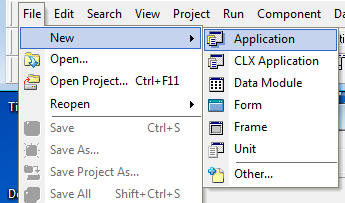
3. Select the ElevateDB tab on the component palette.
4. Click on the TEDBSession component on the ElevateDB tab on the component palette, and then click on the Form1 form. The TEDBSession component will be dropped on the form.
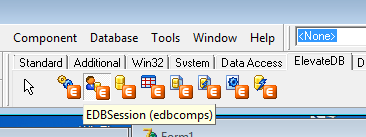
5. Hit the F11 key to bring forward the Object Inspector. In the Object Inspector, click on the SessionName property and change its value to Tutorial, click on the SessionType property and change its value to stRemote, click on the LoginUser property and change its value to the default administrator user name Administrator, and click on the LoginPassword property and change its value to the default Administrator user password EDBDefault. Make sure that the RemoteAddress property is set to 127.0.0.1 (the default) and that the RemotePort property is set to 12010 (the default).
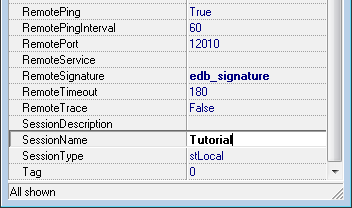
6. Click on the TEDBDatabase component on the ElevateDB tab on the component palette, and then click on the Form1 form. The TEDBDatabase component will be dropped on the form.
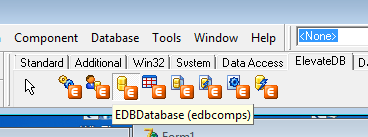
7. Hit the F11 key to bring forward the Object Inspector. In the Object Inspector, click on the SessionName property and change its value to Tutorial. Click on the DatabaseName property and change its value to TutorialDB. Click on the Database property and select the Tutorial database that you have already created from the drop-down list.
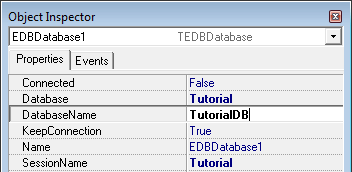
8. Click on the TEDBTable component on the ElevateDB tab on the component palette, and then click on the Form1 form. The TEDBTable component will be dropped on the form.
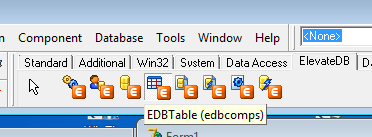
9. Hit the F11 key to bring forward the Object Inspector. In the Object Inspector, click on the SessionName property and change its value to Tutorial. Click on the DatabaseName property and change its value to TutorialDB. Click on the TableName property and change its value to Customer. Click on the Active property and change its value to True. If you have followed all of the steps correctly, the Active property should successfully change to True without error.
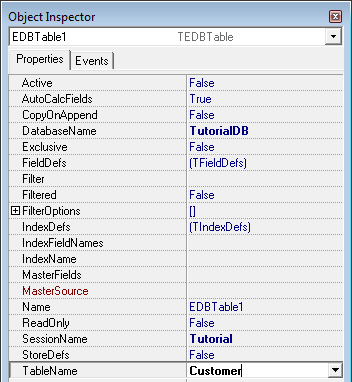
10. Select the Data Access tab on the component palette.
11. Click on the TDataSource component on the Data Access tab on the component palette, and then click on the Form1 form. The TDataSource component will be dropped on the form.
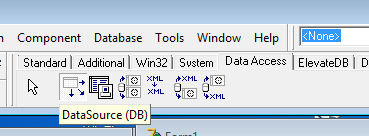
12. Hit the F11 key to bring forward the Object Inspector. In the Object Inspector, click on the DataSet property and change its value to EDBTable1.
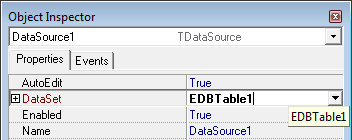
13. Select the Data Controls tab on the component palette.
14. Click on the TDBGrid component on the Data Controls tab on the component palette, and then click on the Form1 form. The TDBGrid component will be dropped on the form. You can use the design-time anchors to resize the TDBGrid component as required on the form.

15. Hit the F11 key to bring forward the Object Inspector. In the Object Inspector, click on the DataSource property and change its value to DataSource1.
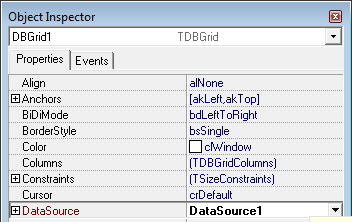
16. Click on the File option from the main menu.
17. Click on the Save All option from the File menu.
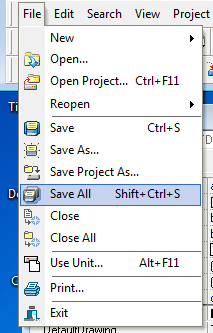
18. Save the project and the main form/unit under the desired names.
You have now successfully created a basic client-server application for ElevateDB.
1. Click on the File option from the main menu.
2. Click on the New option from the File menu, and click on the Application option from the New sub-menu.

3. Select the ElevateDB tab on the component palette.
4. Click on the TEDBSession component on the ElevateDB tab on the component palette, and then click on the Form1 form. The TEDBSession component will be dropped on the form.

5. Hit the F11 key to bring forward the Object Inspector. In the Object Inspector, click on the SessionName property and change its value to Tutorial, click on the SessionType property and change its value to stRemote, click on the LoginUser property and change its value to the default administrator user name Administrator, and click on the LoginPassword property and change its value to the default Administrator user password EDBDefault. Make sure that the RemoteAddress property is set to 127.0.0.1 (the default) and that the RemotePort property is set to 12010 (the default).

6. Click on the TEDBDatabase component on the ElevateDB tab on the component palette, and then click on the Form1 form. The TEDBDatabase component will be dropped on the form.

7. Hit the F11 key to bring forward the Object Inspector. In the Object Inspector, click on the SessionName property and change its value to Tutorial. Click on the DatabaseName property and change its value to TutorialDB. Click on the Database property and select the Tutorial database that you have already created from the drop-down list.

8. Click on the TEDBTable component on the ElevateDB tab on the component palette, and then click on the Form1 form. The TEDBTable component will be dropped on the form.

9. Hit the F11 key to bring forward the Object Inspector. In the Object Inspector, click on the SessionName property and change its value to Tutorial. Click on the DatabaseName property and change its value to TutorialDB. Click on the TableName property and change its value to Customer. Click on the Active property and change its value to True. If you have followed all of the steps correctly, the Active property should successfully change to True without error.

10. Select the Data Access tab on the component palette.
11. Click on the TDataSource component on the Data Access tab on the component palette, and then click on the Form1 form. The TDataSource component will be dropped on the form.

12. Hit the F11 key to bring forward the Object Inspector. In the Object Inspector, click on the DataSet property and change its value to EDBTable1.

13. Select the Data Controls tab on the component palette.
14. Click on the TDBGrid component on the Data Controls tab on the component palette, and then click on the Form1 form. The TDBGrid component will be dropped on the form. You can use the design-time anchors to resize the TDBGrid component as required on the form.

15. Hit the F11 key to bring forward the Object Inspector. In the Object Inspector, click on the DataSource property and change its value to DataSource1.

16. Click on the File option from the main menu.
17. Click on the Save All option from the File menu.

18. Save the project and the main form/unit under the desired names.
You have now successfully created a basic client-server application for ElevateDB.
This web page was last updated on Thursday, November 16, 2023 at 10:39 AM | Privacy Policy © 2024 Elevate Software, Inc. All Rights Reserved Questions or comments ? |
